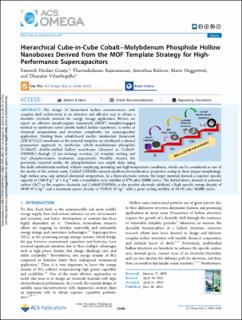| dc.contributor.author | Fatemeh, Gourji | |
| dc.contributor.author | Rajaramanan, Tharmakularasa | |
| dc.contributor.author | Kishore, Amruthaa | |
| dc.contributor.author | Heggertveit, Marte | |
| dc.contributor.author | Velauthapillai, Dhayalan | |
| dc.date.accessioned | 2023-09-15T07:47:52Z | |
| dc.date.available | 2023-09-15T07:47:52Z | |
| dc.date.created | 2023-07-25T09:54:49Z | |
| dc.date.issued | 2023 | |
| dc.identifier.citation | ACS Omega. 2023, 8 (26), 23446-23456. | en_US |
| dc.identifier.issn | 2470-1343 | |
| dc.identifier.uri | https://hdl.handle.net/11250/3089631 | |
| dc.description.abstract | The design of hierarchical hollow nanostructures with complex shell architectures is an attractive and effective way to obtain a desirable electrode material for energy storage application. Herein, we report an effective metal–organic framework (MOF) template-engaged method to synthesize novel double-shelled hollow nanoboxes, in terms of chemical composition and structure complexity, for supercapacitor application. Starting from cobalt-based zeolitic imidazolate framework (ZIF-67(Co)) nanoboxes as the removal template, we developed a rational preparation approach to synthesize cobalt–molybdenum–phosphide (CoMoP) double-shelled hollow nanoboxes (donated as CoMoP-DSHNBs) through (i) ion-exchange reaction, (ii) template etching, and (iii) phosphorization treatment, respectively. Notably, despite the previously reported works, the phosphorization was simply done using the facile solvothermal method, without employing annealing and high-temperature conditions, which can be considered as one of the merits of the current work. CoMoP-DSHNBs showed excellent electrochemical properties owing to their unique morphology, high surface area, and optimal elemental composition. In a three-electrode system, the target material showed a superior specific capacity of 1204 F g–1 at 1 A g–1 with a remarkable cycle stability of 87% after 20000 cycles. The hybrid device formed of activated carbon (AC) as the negative electrode and CoMoP-DSHNBs as the positive electrode exhibited a high specific energy density of 49.99 W h kg–1 and a maximum power density of 7539.41 W kg–1 with a great cycling stability of 84.5% after 20,000 cycles. | en_US |
| dc.language.iso | eng | en_US |
| dc.publisher | American Chemical Society | en_US |
| dc.rights | Attribution-NonCommercial-NoDerivatives 4.0 Internasjonal | * |
| dc.rights.uri | http://creativecommons.org/licenses/by-nc-nd/4.0/deed.no | * |
| dc.title | Hierarchical Cube-in-Cube Cobalt-Molybdenum Phosphide Hollow Nanoboxes Derived from the MOF Template Strategy for High-Performance Supercapacitors | en_US |
| dc.type | Peer reviewed | en_US |
| dc.type | Journal article | en_US |
| dc.description.version | publishedVersion | en_US |
| dc.rights.holder | © 2023 The Authors | en_US |
| dc.source.pagenumber | 23446-23456 | en_US |
| dc.source.volume | 8 | en_US |
| dc.source.journal | ACS Omega | en_US |
| dc.source.issue | 26 | en_US |
| dc.identifier.doi | 10.1021/acsomega.3c00337 | |
| dc.identifier.cristin | 2163393 | |
| dc.relation.project | Direktoratet for internasjonalisering og kvalitetsutvikling i høgare utdanning: NORPART-2021/10095 - HRNCET 2.0 | en_US |
| cristin.ispublished | true | |
| cristin.fulltext | original | |
| cristin.qualitycode | 1 | |

